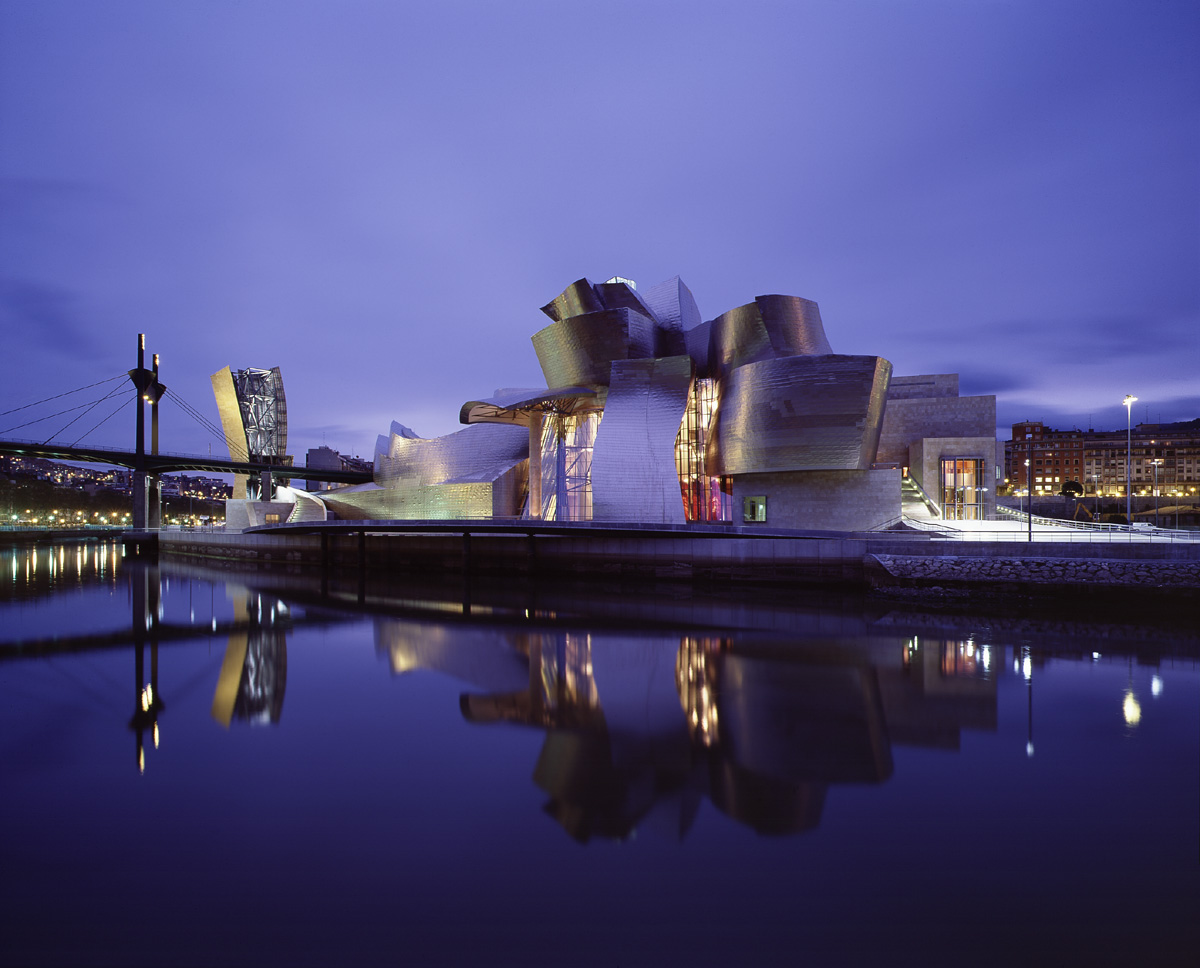The legacy of the Guggenheim Bilbao, completed 20 years ago today in the Spanish port city, is perhaps best summed up by a reversal of an age-old adage: It’s the outside, not the inside, that counts. Having ignited a tourism boom that helped stimulate the economy and rejuvenate Bilbao, it would seem better remembered for the “effect” of its architecture than for the value of its collection. Indeed, since the completion of Frank Gehry’s building in 1997, other cities’ politicians and active leaders have clamored for their own Guggenheim Bilbao (and in one case, even rallied for the exact same design). Abu Dhabi’s Saadiyat Island, Hong Kong’s M+ contemporary art museum, as well as England’s Tate Liverpool are just a few cultural centers that were erected with the “Bilbao effect” in mind.
But it hasn’t been all wine and roses. Others, including the Centro Botín, located about sixty miles west of Bilbao in Santander, Spain, recently rejected all comparisons to the institution: Rather than follow the Guggenheim’s initiative to support the city’s economy by attracting foreign tourists, the center emphasizes enriching the local community by engaging its residents.
Love it or hate it, there’s no question that the Guggenheim Bilbao’s global outlook has helped alter the international art and architecture worlds, leading to both vehement disapproval and ardent support for fixed, billion-dollar tourist destinations fashioned as museums.
On the occasion of the institution’s 20th anniversary today, we asked six architects to share their thoughts on the museum’s legacy and the“Bilbao effect” at large.
Eric Owen Moss
Principal and Lead Designer, Eric Owen Moss Architects
“Bilbao changed the pro forma. So, in that sense, it was shocking in an absolutely positive and important way. Some people have said it closed down all the possibilities. I don’t look at it that way at all. I think it opened up the world again. Frank [Gehry] was really the father to a lot of mischief that followed, some good and some bad. It was really a singular—singular meaning unusual—event in contemporary architecture and I think it will resonate for a long, long time.”
Daniel Libeskind
Founder and Principal Architect, Studio Daniel Libeskind
“That building succeeded in raising the ambitions of institutions, and I think it’s mobilized people to look at architecture in a much more ambitious way. It was a new era for museums and other institutions—a chance to take stock of different forms, different ways of attracting the audience, and a different sense of positioning the project in the urban context. We have seen a kind of renaissance of architecture since that time. I think you have to give Frank credit here for a pioneering spirit. I think the Guggenheim Bilbao is kind of architecture as an art, which shifts things around. And it’s also technically innovative. His use of the computer, his use of a different materiality, that certainly had a big impact on the world. And it still does.”
Patrik Schumacher
Director and Senior Designer, Zaha Hadid Architects
“The Bilbao opened and became such a huge success, I think it helped us to win competitions with our work [which was a little “unconventional” at the time]. Right afterward, we won four or five competitions in a row, where we had lost ten or fifteen before. We were well aware that the atmosphere and receptiveness around unusual architecture had really shifted. We were, in a way, reflected [in this “Bilbao effect”], too, and it made us take off—we really soared. Now, a lot of times we hear that we are invited to competitions that are looking for an iconic landmark, which puts the city on the map. So many cities have been trying to do that. For us it was worked by making the world receptive to this kind of work.
Richard Dattner
Founder, Dattner Architects
“I visited Frank Gehry’s Bilbao Museum shortly after it opened, and was impressed with its novelty, design—soon to be replicated in similar forms elsewhere—and the benefits its notoriety brought to this largely forgotten city. I was disappointed that the stonework was already showing signs of damage and decay. True to its intention, the building had brought me to Bilbao, but the urban texture of the city, its liveliness, people, and the local culture remain more strongly in my memory than the museum. When each city finally has its own Bilbao, along with the new stadium and convention center promising visitors and income, perhaps some of the novelty will wear off, leaving us back in the varied, messy, vibrant, human world of the everyday—perhaps better appreciating its richness and diversity. One can only hope.”
Jürgen Mayer H.
Founder and Principal, Jürgen Mayer H. Architecture Design Research
“Architecture is mostly built in order to create a better future; spatially, economically, socially, culturally, and ecologically. Especially when it comes to activating a larger urban context, expectations for an architecture that can inject a specific energy are quite high. Ideally this does not only lead to a unique building as an institution, but also offers a public space for the citizens to celebrate the city during festivities and even more so in everyday life.”
Shohei Shigematsu
Partner, OMA
“Of course there’s a positive effect and contribution of Bilbao, at least in terms of creating a museum that’s iconic to draw others’ attention from the world. Twenty years has past and [the art world has] changed a lot. But, the iconic museum is, in my theory, taken over by art fairs or art events: The municipalities realize that architecture is static and too much money and too much trouble, which is a very interesting shift—from Frank Gehry’s titanium facade to a wide tent. This is some kind of a ‘post–Bilbao effect,’ in which architecture is no longer capable of hosting this kind of interest of the art world. I think Bilbao was a sign of globalization—the Guggenheim-franchised museum. So, for me, this more site-specific or more local art is against that kind of globalization.”

